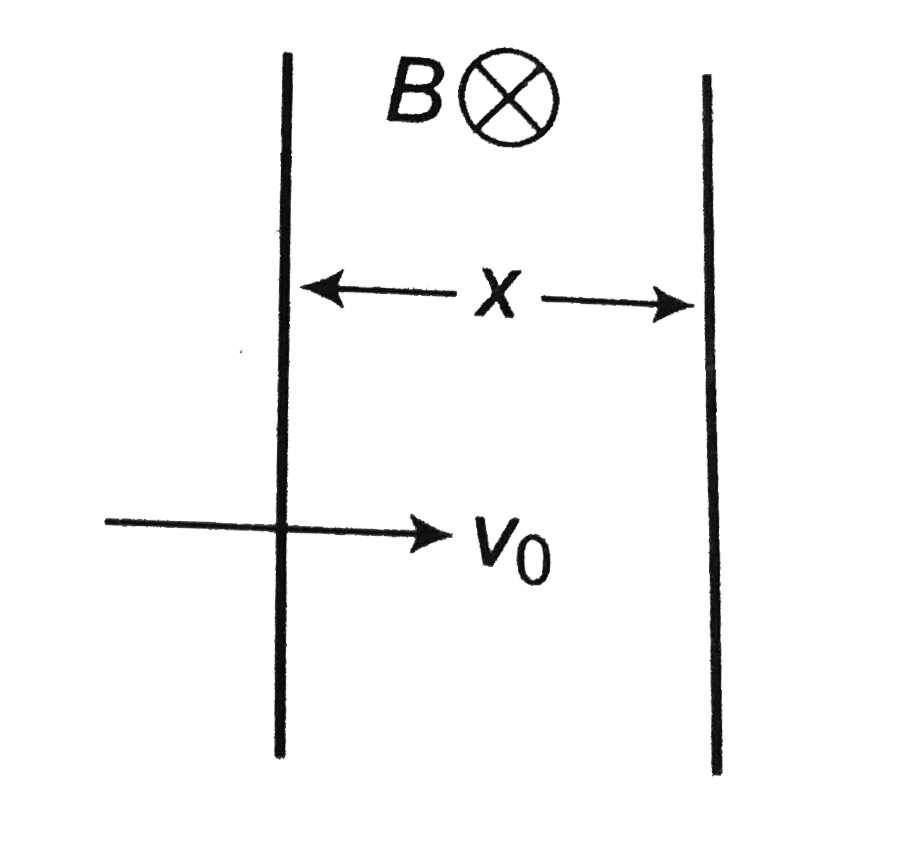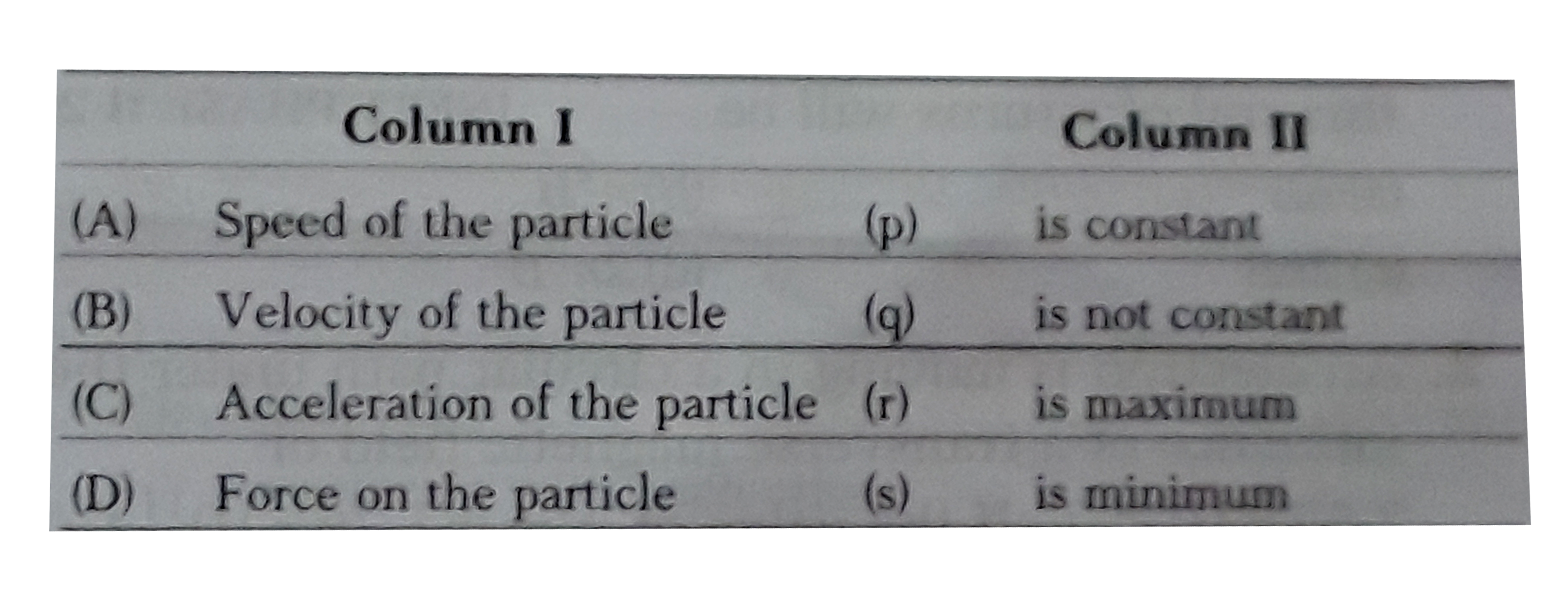A charged particle enters a uniform magnetic field with velocity v0=4m/s perpendicular to it, the length of magnetic field is x=(√32)R, where R is the radius of the circular path of the particle in the field. Find the magnitude of charge in velocity (in m/s) of the particle when it comes out of the field.
The correct Answer is:4
To solve the problem step by step, we will analyze the motion of a charged particle in a magnetic field and derive the final velocity when it exits the field.
Step 1: Understanding the Motion
When a charged particle enters a uniform magnetic field perpendicularly, it moves in a circular path due to the magnetic force acting on it. The radius R of the circular path is determined by the particle's velocity v0 and the magnetic field B.
Step 2: Given Parameters
- Initial velocity v0=4m/s
- Length of the magnetic field x=√32R
Step 3: Finding the Radius of the Circular Path
The radius R of the circular path can be expressed in terms of the magnetic field B and the charge q of the particle using the formula:
R=mv0qB
where m is the mass of the particle.
Step 4: Finding the Angle
From the given length of the magnetic field x, we can relate it to the angle θ subtended by the circular path:
x=Rθ
Given x=√32R, we can write:
Rθ=√32R
This implies:
θ=√32
To find θ in degrees, we can convert:
θ=60∘
Step 5: Velocity Components
When the particle exits the magnetic field, we can resolve the velocity into components. The new velocity v1 can be expressed as:
v1=v0cos(60∘)^i+v0sin(60∘)^j
Substituting v0=4m/s:
v1=4⋅12^i+4⋅√32^j
This simplifies to:
v1=2^i+2√3^j
Step 6: Magnitude of the Final Velocity
To find the magnitude of the final velocity v1:
|v1|=√(2)2+(2√3)2
Calculating this gives:
|v1|=√4+12=√16=4m/s
Final Answer
The magnitude of the velocity of the particle when it comes out of the field is 4m/s.
---
When a charged particle enters a uniform magnetic field perpendicularly, it moves in a circular path due to the magnetic force acting on it. The radius R of the circular path is determined by the particle's velocity v0 and the magnetic field B.
- Initial velocity v0=4m/s
- Length of the magnetic field x=√32R
The radius R of the circular path can be expressed in terms of the magnetic field B and the charge q of the particle using the formula:
R=mv0qB
where m is the mass of the particle.
From the given length of the magnetic field x, we can relate it to the angle θ subtended by the circular path:
x=Rθ
Given x=√32R, we can write:
Rθ=√32R
This implies:
θ=√32
To find θ in degrees, we can convert:
θ=60∘
When the particle exits the magnetic field, we can resolve the velocity into components. The new velocity v1 can be expressed as:
v1=v0cos(60∘)^i+v0sin(60∘)^j
Substituting v0=4m/s:
v1=4⋅12^i+4⋅√32^j
This simplifies to:
v1=2^i+2√3^j
To find the magnitude of the final velocity v1:
|v1|=√(2)2+(2√3)2
Calculating this gives:
|v1|=√4+12=√16=4m/s
The magnitude of the velocity of the particle when it comes out of the field is 4m/s.
Topper's Solved these Questions
- MISCELLANEOUS VOLUME 5BOOK - CENGAGE PHYSICS ENGLISHCHAPTER - MISCELLANEOUS VOLUME 5EXERCISE - Linked Comprehension
84 Videos
- MISCELLANEOUS VOLUME 3BOOK - CENGAGE PHYSICS ENGLISHCHAPTER - MISCELLANEOUS VOLUME 3EXERCISE - True and False
3 Videos
- NUCLEAR PHYSICSBOOK - CENGAGE PHYSICS ENGLISHCHAPTER - NUCLEAR PHYSICSEXERCISE - ddp.5.5
14 Videos
Similar Questions
A charged particle enters into a uniform magnetic field with velocity v0 perpendicular to it , the length of magnetic field is x=√32R, where R is the radius of the circular path of the particle in the field .The magnitude of charge in velocity of the particle when it comes out of the field is

View SolutionWhen a charged particle enters a uniform magnetic field its kinetic energy
View SolutionA charged particle enters in a uniform magnetic field perpendicular to it. Now match the following two columns.

View SolutionA charged particle enters a uniform magnetic field perpendicular to it. The magnetic field
View SolutionIf a charged particle enters perpendicular in the uniform magnetic field then
View SolutionThe path of a charged particle in a uniform magnetic field, when the velocity and the magnetic field are perpendicular to each other is a
View SolutionA charged particle enters a unifrom magnetic field with velocity vector at an angle of 45∘ with the magnetic field . The pitch of the helical path followed by the particles is ρ . The radius of the helix will be
View SolutionA charged particle moves in a uniform magnetic field. The velocity of the particle at some instant makes an acute angle with the magnetic field. The path of the particle will be
View SolutionA charged particle enters in a magnetic field B with its initial velocity making an angle of 45° with B. The path of the particle will be
View SolutionIf a charged particle is a plane perpendicular to a uniform magnetic field with a time period T Then
View Solution